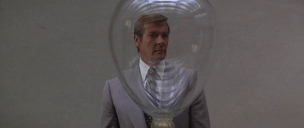
For various reasons, I haven’t been feeling so well lately. And when I feel like shit I like to take it out on bad movies. So I am very glad to be reviewing a Bond film I honestly despise, considered by some people to be The Worst James Bond Movie Ever Made. Of course, things would be pretty boring if it weren’t also acclaimed by almost-as-many people as the quintessential representation of everything this series is, was, or should be. It’s the Bond movie parents think they can safely pass down to their children…especially if their children have a pre-existing interest in sci-fi films, like some of us.
Because of that, it’s the first James Bond movie a lot of people (who aren’t me) see, forever coloring their expectations of the franchise. I’ll admit I’m predisposed to enjoy some of the elements you Normals may find the most ludicrous. But even for me, Moonraker goes right off the rails, abandoning any pretensions of being a spy-fi thriller made for people with functioning brains. In that, and one more area, it is the quintessential Bond movie: things start off well, but get steadily worse as they go on…and this movie does go on. At length. So at least it’s in good company, eh?
Made as a conscious cash-in on the Space Craze that gripped Hollywood in the wake of Star Wars, this film got a lot of love when it came out for exactly the same reasons most people now choose to crucify it. It was safe, bland, predictable, and exactly what studios thought audiences wanted. And they were right: Moonraker made more money than any previous Bond film. (Not adjusting for inflation, because who has time to do math these days?) Somebody must’ve loved it. As I hadn’t seen it in years, I was honestly curious to see how this film stacked up against its own notoriety. Is it, in fact, the Worst Thing with Bond’s Name On It?
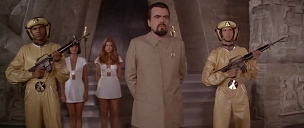
Well, no. Not now that Die Another Day exists. But the inescapable fact is Moonraker has sequlitis in the worst way. Its plot is a wholesale recycling of The Spy Who Loved Me…which in itself was just a bigger-budget retread of You Only Live Twice. In fact, the three form a pretty devastating little trilogy I officially dare you to sit through sometime. See if you’re still a Bond fan when you come out the other end of that. They’re all the same movie, shifted to slightly different locations, with Bond regenerating between entries from a bored-looking Sean Connery to an arrogant prick-looking Roger Moore. In all three, Bond seeks to stop a mad industrialist from annihilating most of Earth’s population and declaring themselves ruler of the resulting radioactive wasteland.
Now, there’s a quote from someone who may or may not have been Albert Enstein. Most of my target demographic’s probably encountered it while playing the first-person shooter video game series Call of Duty. It shows up every fourth or fifth time you die while the game reloads your previous save, and it goes a little something like this:
“I don’t know what weapons World War III will be fought with, but World War IV will be fought with sticks and stones.”
Apparently, none of Bond’s classical supervillains ever came across this quote during their educational lives. At least their end games have improved over time…I’m still not sure Blofeld had one back in ’67, and Stromburg failed to consider how global nuclear winter might effect his beloved sea life. At least this year’s Villain has his own space station safely in orbit, high above the initial conflagration. But I’m still foggy on why anyone ever considered starting WWIII a good idea. Even Jaws (still Richard Kiel) – the apparently ruthless international henchman-for-hire – greets this plan with an unmistakeable “What the fuck?” face.
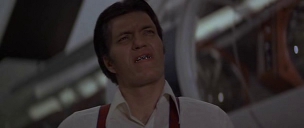
Because trying to start World War III is crazy. I mean, we’re all agreed on that, right? Not even Reagan was that crazy. You need to be an entirely different type of crazy to head a major shipping firm…or the aerospace company in charge of building space shuttles. Ruthless Business Tycoon crazy is not Try To Take Over the World crazy unless your name is Lex Luthor. You need to be…let’s call it “Goldfinger crazy.” Most of Bond’s post-Goldfinger villains have been plain ol’ stark raving mad.
With Moonraker the series officially Godwins itself. Our Villain, Hugo Drax (Michael Lonsdale), is an ex-Nazi in all but name – secretly hiding out in South America, planning to scare up some lebensraum for his new space-based Master Race by nerve gassing the rest of us from orbit. Nevermind you’d need way more gas than Drax has manufactured to do the job right – I’ve got battered fish to fry. If I were in this movie, I’d ask Drax, “What happens when Russian and America engage the ‘lob nukes first, ask questions later’ fail-safe policies we know they both have, since its 1979 and detente’s about to go the way of the dinosaurs? Your Master Race won’t get too far if the Earth sterilizes them on contact, smart guy.” But what do my mongrel brain and I know?
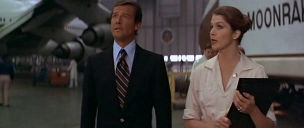
Well, I know space shuttles aren’t usually transported with full fuel tanks. Yet, here’s the “Moonraker” shuttle, being hijacked in flight by random stowaways. So once again Bond (still Roger Moore) gets to track down a piece of military/industrial hardware you’d think would be big enough to find with satellites, the trail of which leads him around the world, into various run-ins with some manner of female counterpart – in this case CIA Agent Dr. Holly Goodhead (Lois Chiles) – a seemingly-indestructible henchmen (Jaws) and a series of vehicle chases (through Venice and the Upper Amazon). Eventually, Bond confronts the villain, wins, says a quip, and winds up shagging his female counterpart on some exotic means of transportation as the credits roll.
We and everyone involved at Eon productions already knew this going in. And during the Lewis Gilbert era Eon used this knowledge as an excuse. They got sloppy, and this is the sloppiest Bond film to date. We know Drax is a villain by his beard and by the bored, Stock Villain performance Lonsdale turns in. Hard to believe this is the same guy who played the priest in Orson Welles’ The Trial…but then again, he’s a Serious Actor obviously slumming in a “Hollywood” production (payed for by tax-dodging Brits, but details, details).
There was a lot of “slumming” going on at the time. Why, just the year before this movie came out, back on the 007 Stage at Pinewood Studios, Marlon Brando was getting $19 million to read his lines off cue cards. That, and tax avoidance, prompted this production to move to France, so there are lots of Anglo-French actors all over this picture, standing in for Drax’s supposedly-Californian staff. That’s probably why so few people actually speak, save Drax’s personal pilot, Corinne Dufour (Corinne Clery). What’s this? The villain has a hot babe helicopter pilot? And Bond’s seducing her? Well, she’s obviously Not Long For This World. After all, the villain has to kill someone so we all know how bad he is…other than by Evil Beard, of course.
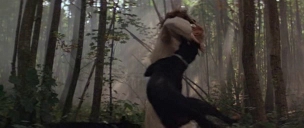
With Corinne’s death, the entire tone of the film takes a hard right turn. As before, with the various shark- and piranha-based Unreliable Henchpeople Disposal Systems, Gilbert’s camera pans away before we see anything good and gory. But in contrast to those over-designed death traps, this is a simple scene of a woman being run down by hunting dogs for helping a spy snoop through her boss’ stuff. There’s nothing wrong with it (besides the pan away) – in fact, it made me sit up and think I’d misjudged this entire flick. But now that I’ve watched it twice I can see Corinne’s death for the desperate plea it really is. This movie’s leading female character’s name is “Goodhead” and yet with this it begs us to take it seriously. Corrine’s death scene exists to let us know actions have real consequences in this universe…a universe where supervillains manage to construct massive space stations with no one noticing the hundreds of shuttle launches necessary for such a thing. Space stations where the artificial gravity’s strongest in the core and weakest out by edges, exactly the reverse of how it should be…and was in “serious” sci-fi movies ten years older than this one. One dead girl can’t make up for all that. And besides, by now we know the first girl Bond sleeps with in a film is doomed – doomed! That’s been true for over ten years as well, by this point.
So seventy-five percent of Moonraker is a route, mechanical exercise in sending the Third Bond through the same Formula the producers once gave Roald Dahl. From California and Corrine, Bond goes to Venice and a glass factory…with a secret nerve gas lab in the back. Protected by a door that can only be opened by playing the tones from Close Encounters of the Third Kind on its keypad. (This is how the Bond theme wound up in The Goonies – FYI.) Yeah, I can take this movie seriously, no problem…or I could, if the next scene weren’t so stupid.
Bond steals a vial of liquid from the secret lab, then contacts MI6 to…drag M (still Bernard Lee) and the British Minister of Defense, Sir Gray (Geoffrey Keen), down to Venice, the better to expose the secret lab to them in person. Of course, by this point, Drax has cleaned the whole place up and moved the lab out to Brazil. So Bond called M and Sir Gray down there just to embarrass them with his incompetence. At least this sets up yet another scene of M suggesting Bond take “a leave of absence” and deal with the problem on the sly. Then he gives M the vial of nerve agent for Q to analyze.
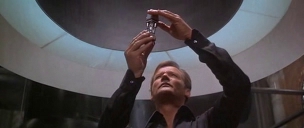
If he’d just called Q first, there’d be no need for him to go “on leave” and the pace of the film would be greatly improved. But there’s a Formula and it must be followed to the letter! These trains have to run on time, by God, no matter what it takes to make that happen.
Except the train’s derailed for tension-free chase sequences with strong family resemblances to chases from Live and Let Die and Man with the Golden Gun. There are some decent action beats in each…and I especially like the coffin-based, knife throwing assassin who shows up in Venice for…like…a second…but as set-pieces they stop the story instead of aiding its progression. The chase through the canals, with Bond on a motorized gondola vs. henchmen in more conventional boats, is well-directed…until the very end, when we get another flagrant tone shift with the literal flip of a switch.
This is the movie where Bond’s motorgondola becomes a hovergondola, allowing him to scoot through the plazas at…a brisk, walking pace. This is accompanied by not one, not two, not three, not four…but five “comedic” reaction shots. Including one from the infamous Double-Take Pigeon.
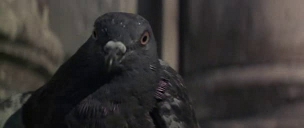
I swear, Special Agent Jinx Johnson is more popular than this bird, making him/her the most universally despised character in the Bond franchise. As if pigeons do double takes naturally. Don’t blame the poor bird, you guys. Blame the guy who ran this shot backward, creating the (transparent) illusion of a double take. Was it you, Gilbert? Or you, editor John Glen-no-relation-to-the-famous-astronaut? I hold you both accountable…but considering how much time we’ll be spending together very shortly, I’m gonna keep a special eye on you, John.
Bond follows the trail to Rio and the destruction of any menace Jaws once possessed. The fight on top of the cable cars is still nice, though less nice now that I’m watching these things in HD and the rear screen projection can stand out so much. The thing about Jaws is, I understand what happened: the producers listened to their fans, which is something movie producers should never, ever do. It doesn’t help. All it does in this case is reduce a once-genuine threat to the Odious Comic Relief. What can I say that hasn’t been said before? Why didn’t I just do this review as a series of questions?
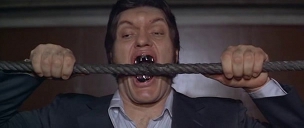
Why is Jaws so indestructible? It didn’t matter back in Spy, when he was just that movie’s Oddjob…but here Jaws lives through shit that would make Daffy Duck shake his head in disbelief. How much rum did he bribe Baron Samadi with, anyway? I guess he can afford it, being an international people-killer. Scaramanga bought himself that sweet island, complete with personalized funhouse, so why shouldn’t Jaws be able to afford his own neigh-invulnerability? Even Jack Warner’s old short cartoons had higher dramatic stakes than this…though both used the Love Theme from Romeo & Juliet in the pretty much the same way, so maybe the parallels are intentional.
No surprise, after years of toys, comic books and TV showings, quite a few children became Bond fans throughout the 60s and 70s. And for a variety of reasons (“he’s awesome” “he’s indestructible “he don’t take no shit from no one”) children loved Jaws. I don’t know if that would’ve amused Fleming or horrified him. He was an elitist…but he wrote an original treatment for Moonraker: The Movie back in the mid-50s and spent the middle period of his career trying to bring Bond out to as wide an audience as possible. Full of contradictions, that man. Like his protagonist…He always seemed to hate it when people called Bond a “hero.”
Dr. Agent Goodhead, though, actually is a hero, thanks to her remaining somewhat competent throughout the entire adventure…despite her inevitable kidnapping. (At least it occurs off-screen…meaning Bond is the second “secret” agent Drax captured that day. Sweet Jesus, there’s nothing “secret” about these people.) Props to her for not getting knocked out in a single punch and for going upside people’s heads with gas cans when the need arises. Plus her day job’s at NASA, so she can be the pilot when Bond stows away on one of Drax’s space shuttles, an hour and a half into the two hour movie. Because Bond can rattle on and on about military hardware, fine dining, games of chance, international super assassins, the “proper” ways to make or consume booze, and obscure poisonous orchids from the depths of the rainforest…but fly a space shuttle? All by himself? That would be just plain damn unrealistic.
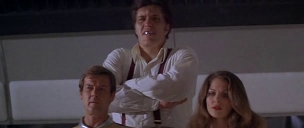
Besides, the shuttle gets to Drax’s station on autopilot, so that’s convenient…I guess Agent Dr. Goodhead’s pretty superfluous, really…until the very end, when she files the shuttle so Bond can shoot down the few nerve gas pods Drax managed to eject. It’s all I can do not to scream, “Use the Force, James!” during this scene, as his targeting computer tries and fails to lock on to the final bomb. What would Fleming have thought of James Skywalker?
Actually, with all the grandiose music and zero-gravity wirework, it plays more like a 2001 cash-in than a Star Wars cash-in…until the climactic “laser” battle. Because the U.S. of this universe totally had space-based Marine Corps units with laser cannons and rocket packs. In 1979! Why not? The British Intelligence Service has exploding bandoleers and wrist-mounted dart guns. Aerospace billionaires have space stations and radar jamming devices. Why not end on a big laser battle? It’s certainly paced better than the underwater fight from Thunderball.
I’m not saying I can’t take any of this seriously. The film has to meet me half way by either picking a consistent tone or being really, really clever with its tone shifts. Moonraker fails on both counts where every previous Bond film succeeded to at least some degree. Even the worst of them were consistent, taking themselves and their overall badness too damn seriously. Moonraker can’t even decide what it wants us to take seriously within the same damn scene.
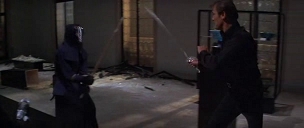
Example: after sneaking out of the secret lab with a shirt pocket full of Insta-Kill, Bond has a fight with international akido instructor Toshiro Suga (playing Drax’s chief bodyguard, Chang) in the lobby of that Venetian glass factory…which is also a glassware museum. It’s a well-staged fight, well-shot and well-executed…if you can ignore Chang’s monumentally stupid decision to attack Bond with a kendo sword (possibly the least-lethal sword in existence, next to a toy lightsaber). Or his decision to swing for the glassware, rather than the superspy he’s supposed to be killin’. The fight moves up into a clock tower (because European buildings have those) and Bond tosses Chang through the clock-face. Since there’s a full dinner concert going on in the street below, Chang takes a header into a grand piano. Instead of cracking the thing (and himself) in half, Chang’s head punches through the piano, exiting the other side in a shower of wires and sawdust. Hey, just like a cartoon, right? Bond tops all this off by misquoting Casablanca (where no on ever said, “Play it again, Sam”), endangering his Classic Film Lover’s street cred.
You see what I mean? The problem isn’t that Bond goes into space. That doesn’t even happen until the last act and, frankly, the space stuff is stronger than the Earth-bound adventure that set it up. This movie’s problems are systematic, almost as if Eon assembled everything weak about their previous efforts. Once again, the boring, one-note villains are overwhelmed by Ken Adam’s glorious sets, the self-conscious-humor-to-self-conscious-thrills mix is all out of whack, and the overall movie’s a limp repeat of at least two previous films.
So yes, it is one of the worst Bond movies ever made, though not for the superficial reasons most people pick out. If this is the kind of thing screenwriter Christopher Wood turns in when he’s flying solo, it’s no wonder Richard Maibaum returned two years later, attempting to salvage what was left of Bond as the series jumped feet-first into that darkest of Dark Times: the 1980s.
![]()
![]()
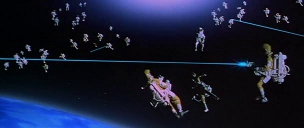

And we have now re-aligned into total agreement. I felt the worst part of this movie is just how many times the villains try and fail to kill Bond-by the time we get to that space station, any confidence at all in Drax and his stooges is completely gone. Drax is quite possibly the least menacing Bond villain until we get Joe Don Baker, International Arms Dealer….but that’s less a problem because Joe Don just needs to make us believe he could take Timothy Dalton with a huge machine gun when Dalton just has his little PPK, after a movie of Dalton spending more time romancing a D’abo than doing his unstoppable Bond thang (and honestly okay with that). Here Drax is supposed to be Hitler II: Electric Boogaloo when he’s really Hitler IV: In Space.
Not to mention that Drax, for all of his supposed brilliance that (in his mind) entitles him to rewrite Homo sapiens‘ DNA, makes easily the most inexplicably dumb move right off the block. He steals a Moonraker because one of his own develops a problem. First, most businesses, the client tends to want to investigate when their orders aren’t fulfilled. Second, he OWNS THE FACTORY, for crying out loud–he can’t simply cobble the necessary spare parts? What’s the rush?
Note to would-be supervillain businessmen everywhere: Until you conquer the world, the customer comes first.
I’ll give you Drax not being too high on the villian list but two things I did enjoy: 1. Michel Lonsdale oozed with swarthy charm and culture 2. Some of his lines were great such as:
“Mr. Bond, you persist in defying my efforts to provide an amusing death for you, why did you break off the engagement with my pet Python ?”
“Frederick Gray, What a surprise ! And in distinguished company, all wearing gas masks. You must excuse me, gentlemen, not being English, I sometimes find your sense of humor rather difficult to follow.”
“Allow me to introduce you to the airlock chamber. Observe, Mr Bond, your route from this world to the next.”
Good ones, yes…but in the time it takes him to say “You appear with the tedious inevitability of an unloved season,” he could have killed 007 and Goodhead five times over and had a cup of tea. Instead, he just stands there and trots out more 50-point-bonus Scrabble words while Bond gets Jaws on his side, prevents the 101st Spaceborne from getting obliterated and ultimately upends his grand plan.
Second note to would-be supervillains everywhere: When you have the opportunity to off the lead good guy, take it.
Third note to would-be supervillains everywhere: I don’t care if you did get a 900 on the English portion of your SAT–SHUT THE HELL UP.
Since we’re on the subject of murder attempts, why did Drax attempt to kill Bond that first time ? Bond knew nothing at that point and killing an MI6 agent in YOUR OWN HOME would cause a lot of headaches. Of course, we all know the answer. The film just wanted to leap into the action.
Dunderheaded though that might be, it does at last prove my theory that Bond is superhuman. I don’t know if he officially broke our world’s record for “highest amount of gs survived for the greatest amount of time without so much as a nosebleed” but he certainly gave it a run for its money. I’ve come to suspect he’s actually an exiled Gallifreyan who struck a deal with the British Secret Service at some point in the early 60s: fantastical alien technologies in exchange for the sweetest day-job on planet Earth. This would explain how everyone around him ages naturally while he regenerates into a new form every decade or so. This would also explain how he manages to keep his job, what with his being such a primadona spoiled brat of an employee – always stalking out of M’s office in a huff to take some “temporary leave of absence.” No wonder that, by this point, we see M proudly playing along…though he’d probably been doing that since Thunderball. Whatever gets results, right?
You have given me a lot to think about.
Then I consider my mission accomplished.
It’s odd how two people can watch the same movie and see completely different films. I love Moonraker ! There’s almost never a dull moment in it, except for the ones where Lois Chiles is onscreen. (They should have made her the villain, since she come across as a total icy bitch.) Ever since Day of the Jackal – another movie I adore – I’ve been a fan of Michael Lonsdale, so it was nice to see him getting work, even as a Bond villain. The Worst Bond movie is the one where Jonathan Pryce was the villain. The only good thing in that is the snooty talking car, which Bond ‘punishes’ by crashing her into a Hertz dealership. She’s also all I can remember of the plot.
You are speaking of Tomorrow Never Dies. I thought the plot was great, a media mogul starting a war for ratings. The problem I had with it is that the story in marred by action sequences and action hero Bond; He takes a three man beating without a mark on his face.
At the time I didn’t mind it, but I’d missed Goldeneye and hadn’t seen a Bond movie in theaters since License to Kill aka Bond Goes Lethal Weapon. I’ve never felt a need to watch it since, but at the time I enjoyed Yeoh, the villain’s plot and…uh…um….I guess the action?
Guess there’s a reason I never watched it again.
This is the point where the series really just choked on it’s own excess*. Before, it was too much but at least they actually, kind of, kept the cold war theme in background in a fairly intelligent matter. Here, this connection between Bond and plot is just too much to believe. What also really kills this film is the often ridiculous Jaws. For example, what was an exiciting edge-of-your seat stunt sequence with Bond and a thug battling for a parachute while falling from thousands of feet in the air ends up being a cartoon farce with Jaws landing in a circus tent.
*Cubby Broccoli would pay for the extravagance of this film right into the mid 80’s with tighter budgets and less locales. What also didn’t help is they kept throwing increasingly huge amounts of money at 50+ year old Roger Moore to stay in the role of Bond when he should have hung up his tux at least one film early.
As a matter of fact, India and France was planned to be shooting locations for MR but ended up in Octopussy and A View To a Kill respectively.
IIRC For Your Eyes Only was to be Moore’s last Bond, then Sean Connery signed up for Never Say Never Again and they didn’t want to risk putting a new guy in there, so you get Octopussy. Really wish FYEO was Moore’s last, it’s easily my favorite of his Bond outings.
I know in the minority but I feel that Octopussy was Moore’s best. The highlight of the film was Bond scrambling to the circus tent to stop the bomb going off which beat the hell out of a similar sequence in Goldfinger.
…And half a dozen other films with similar sequences.
There’s stuff I liked about Octopussy, and the circus stuff was some of the best of it, but it didn’t sustain the elements that I liked the best long enough, and there are too many things that don’t work (yes, Maude Adams, I’m looking at you) for me to love it. It’s head and shoulders above A View to a Kill though.
The woman who played Magda, Octopussy’s right hand female, was FAR better suited for the title role than Maude Adams.